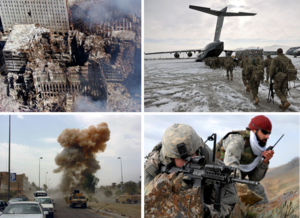
Back الحرب على الإرهاب Arabic Guerra contra'l terrorismu AST Terrorizmlə müharibə Azerbaijani Терроризмға ҡаршы һуғыш Bashkir Вайна супраць тэрарызму Byelorussian Война срещу тероризма Bulgarian সন্ত্রাসের বিরুদ্ধে যুদ্ধ Bengali/Bangla Rat protiv terorizma BS Guerra contra el terrorisme Catalan شەڕی تیرۆر CKB
| War on terror | |||||||
|---|---|---|---|---|---|---|---|
Photographs, clockwise from top left: Aftermath of the September 11 attacks; U.S. servicemen boarding an aircraft at Bagram Air Base, Afghanistan; a U.S. soldier and Afghan interpreter in Zabul Province, Afghanistan; explosion of an Iraqi car bomb in Baghdad. Map: Countries with major military operations of the war on terror. | |||||||
| |||||||
| Belligerents | |||||||
| Main countries: |
Main opponents:
| ||||||
| Commanders and leaders | |||||||
|
|
| ||||||
| Casualties and losses | |||||||
|
4.5–4.6 million+ people killed[a] (937,000+ direct deaths, 3.6–3.7 million indirect deaths)[b] At least 38 million people displaced[c] | |||||||
The Global War on Terrorism, or War on Terror, is a campaign that the United States and some of its allies started in September 2001 to remove terrorist groups and to punish the states that sponsor terrorism. It replaced the later War in Afghanistan and Iraq War. United States President George W. Bush argued that the countries like North Korea, Cuba, Iran, Iraq, Syria, and Libya (also known as the Axis of Evil) were a direct threat to the United States and its allies. The term was typically used with a particular focus on militant Islamists and al-Qaeda.
The Administration of former U.S. President Barack Obama used the term Overseas Contingency Operation.[2]
- ↑ "Video: Pres. Bush Declares War on Terror". ABC News archives. September 15, 2001.
- ↑ Obama Scraps 'Global War on Terror' for 'Overseas Contingency Operation'.
<ref group=note> tags on this page, but the references will not show without a {{reflist|group=note}} template (see the help page).
Cite error: There are <ref group=lower-alpha> tags or {{efn}} templates on this page, but the references will not show without a {{reflist|group=lower-alpha}} template or {{notelist}} template (see the help page).

